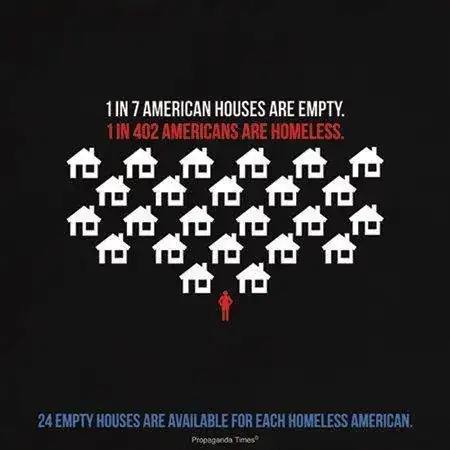I just saw this meme on Facebook:

Since this question answered the ratio question, I would like to know if these houses are "available for" those homeless?
I just saw this meme on Facebook:

Since this question answered the ratio question, I would like to know if these houses are "available for" those homeless?
According to Census.gov, in the 1st quarter of 2014 there were 18,319,000 vacant housing units.
The number of homeless is debatable, because those in institutions or staying at friends' places are not counted in government reports like the Annual Homeless Assessment Report to Congress (which estimated 610,042 homeless in January 2013). This site mentions 1,750,000 homeless, presumably on 7.1.2014, but I could not find the AHAR 2014.
18319000 / 610042 = 30 vacant homes per homeless.
18319000 / 1750000 = 10 vacant homes per homeless.
Some of those are summer homes, though, so using Year-Round Vacant Housing Units, we get this:
13785000 / 610042 = 22.6
24 empty houses for each homeless American (assuming only the USA) seems like a reasonable estimate, especially since the meme is older than 3 Feb 2012.
Still, most of those are not up for sale or rent. Totaling the vacancies for rent (3710000) and for sale (1521000) gives us:
5231000 / 610042 = 8.6
Which is similar to the 6 mentioned in the meme in this related/duplicate question.
So the answer is NO; 24 is a rather gross exaggeration of the number of homes available for sale/rent.
Also, "houses" as depicted in the meme is an exaggeration, as according to the U.S. Bureau of the Census:
A housing unit is a house, an apartment, a mobile home, a group of rooms, or a single room that is occupied (or if vacant, is intended for occupancy) as separate living quarters. Separate living quarters are those in which the occupants live and eat separately from any other persons in the building and which have direct access from the outside of the building or through a common hall.
As for being available to the homeless, Utah cut down its homeless population by 74% by giving them free homes (in hopes of saving money on ER). And a month later, it's 78%:
In eight years, Utah has quietly reduced homelessness by 78 percent, and is on track to end homelessness by 2015. How did Utah accomplish this? Simple. Utah solved homelessness by giving people homes. In 2005, Utah figured out that the annual cost of E.R. visits and jail stays for homeless people was about $16,670 per person, compared to $11,000 to provide each homeless person with an apartment and a social worker. So, the state began giving away apartments, with no strings attached. Each participant in Utah’s Housing First program also gets a caseworker to help them become self-sufficient, but they keep the apartment even if they fail. The program has been so successful that other states are hoping to achieve similar results with programs modeled on Utah’s.
It sounds like Utah borrowed a page from Homes Not Handcuffs, the 2009 report by The National Law Center on Homelessness & Poverty and The National Coalition for the Homeless. Using a 2004 survey and anecdotal evidence from activists, the report concluded that permanent housing for the homeless is cheaper than criminalization. Housing is not only more human, it’s economical.
San Francisco's mayor's chief of homelessness policy, Bevan Dufty, had this to say:
Look, we're going to spend the money one way or another - either through expensive jail, shelter, emergency calls and so forth, or by investing in housing. It's so clear what the best way to spend it is. With housing you not only give people better lives, you save money in the long run.
That might not be the case in areas with high real estate costs and for-profit prisons, but it would be a better use of homes than demolishing them due to lack of buyers. Also, some homeless pay property taxes.